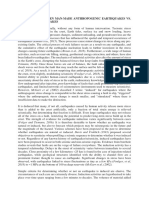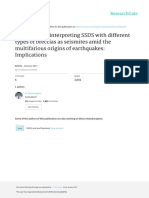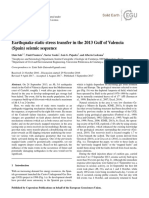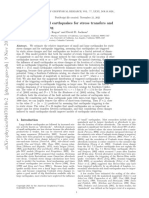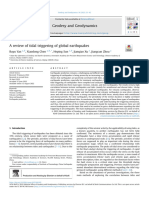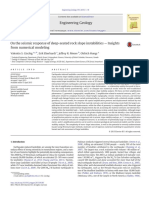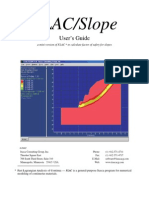Barbour Et Al-2019-Geophysical Research Letters
Barbour Et Al-2019-Geophysical Research Letters
Uploaded by
michgebCopyright:
Available Formats
Barbour Et Al-2019-Geophysical Research Letters
Barbour Et Al-2019-Geophysical Research Letters
Uploaded by
michgebOriginal Description:
Copyright
Available Formats
Share this document
Did you find this document useful?
Is this content inappropriate?
Copyright:
Available Formats
Barbour Et Al-2019-Geophysical Research Letters
Barbour Et Al-2019-Geophysical Research Letters
Uploaded by
michgebCopyright:
Available Formats
COMMENTARY Induced Seismicity Reduces Seismic Hazard?
10.1029/2019GL081991
Andrew J. Barbour1 and Fred Pollitz1
Key Points: 1
• Geodetic data indicate a close
United States Geological Survey, Menlo Park, CA, USA
relationship between crustal strain
rates and induced earthquakes
• Induced earthquakes might reduce Abstract Earthquakes caused by human activities have been observed for decades. Often these are
the seismic hazard in the long run related to industrial activities pumping fluids into deep geologic formations, like with wastewater
• Hazard‐reducing scenarios hinge
critically on a few major
disposal. The simplest theory connecting these processes to earthquakes is straightforward: injection leads to
assumptions fluid pressure changes that either reduce the strength of preexisting faults or generate new faults. In practice,
the conditions that lead to induced earthquakes are not always clear in ways that can be generalized.
Kao et al. (2018, https://doi.org/10.1029/2018GL079288) show how the distribution of induced earthquakes
Correspondence to: in Western Canada relate to natural rates of deformation in the crust. Using these new results, they discuss
A. J. Barbour, an intriguing paradox: induced seismicity can cause short‐term increases in the seismic hazard that are
abarbour@usgs.gov followed by a period of reduced seismic hazard. Such hazard‐reducing scenarios are plausible but hinge
upon simplifying assumptions about how the crust stores and releases strain energy in the form
Citation: of earthquakes.
Barbour, A. J., & Pollitz, F. (2019).
Induced seismicity reduces seismic
hazard?. Geophysical Research Letters,
46. https://doi.org/10.1029/ The slow migration and deformation of Earth's tectonic plates leads to a process of energy storage and
2019GL081991
release. Because this happens over geologic timescales, we have obvious expressions of this process to study
Received 9 JAN 2019 including active faults, volcanic eruptions, or ongoing uplift of mountain ranges, for example.
Accepted 30 MAR 2019
Accepted article online 5 APR 2019
Earthquakes reflect this process on timescales that humans may experience in their lifetime. They occur on
faults where deformation in the crust has concentrated into a narrow planar zone of fault slip; the seismic
waves from great earthquakes can cause the earth to ring like a bell. We can identify the time, location,
and size of an earthquake by its signals recorded on a collection of seismometers—instruments that measure
Earth's vibrations. We can also identify the style of faulting in an earthquake by looking at details of the
seismic signals and use that information to determine the stresses acting on the fault.
During the periods between earthquakes, the crust is relentlessly warped, stretched, and compressed. Earth
scientists call this strain accumulation, which builds up over decades or centuries until it is released by earth-
quakes; measuring this slow strain accumulation requires high‐precision instruments. That is—we need to
measure changes of about one part in a billion to measure typical changes in strain. If we had a rubber band
stretched across the width of Greenland, we would need to measure a change in its length equal to the thick-
ness of a few human hairs; the navigation in your smartphone is not good enough to witness such small
changes, but modern geodetic technology is. Although modern geodesy gives us the ability to measure tiny
changes in strain, seismology is also a useful tool for understanding how and where the crust releases stored
strain energy.
Kao et al. (2018) study a region of Western Canada that is riddled with deep wells used for enhanced oil‐
recovery, waste‐fluid disposal, and hydraulic fracturing (or fracking) for the production of oil and gas from
“tight” reservoirs; these industrial activities have caused a remarkable increase in the number of earth-
quakes in recent years and, consequently, a change in seismic hazard. The authors report that the distribu-
tion of induced earthquakes in this region follows the distribution of strain rates in the crust, with most
earthquakes occurring where strain rates are highest. To measure strain, they use a network of Global
Navigation Satellite System (GNSS) stations, taking differences among their relative positions over time
(Figure 1). (GNSS is the generic collection of satellite positioning systems, which includes the United
States' Global Positioning System or GPS.) Whether natural or induced, the magnitude of an earthquake
is an indication of the seismic moment—the product of the distance a fault has slipped, the size of the area
that slipped, and the stiffness of the host rock. The brittle part of the crust where most earthquakes happen is
called the seismogenic zone, and its thickness can be used in conjunction with strain rates to estimate what
Published 2019. This article is a U.S.
Government work and is in the public the total seismic moment budget is; this can tell us what the largest earthquake possible in a region (like
domain in the USA. Western Canada) could be.
BARBOUR AND POLLITZ 1
Geophysical Research Letters 10.1029/2019GL081991
Figure 1. Geodetic measurements and the idealized earthquake cycle. Strain accumulates around a fault because of fric-
tional resistance to far‐field plate motion. Eventually, stresses on the fault overcome its frictional resistance and it slips,
which releases stored strain energy and generates an earthquake (with aftershocks). This process is known as elastic
rebound. GNSS stations at the surface of a deforming crust move at different paces depending on their proximity to
the fault: The average strain rate between any two stations would be the difference in the slopes of their respective dis-
placement time series (see lower panel) divided by the distance between them. GNSS = Global Navigation Satellite System.
This leads us to the main paradox in Kao et al. (2018): creating earthquakes can lower the seismic hazard
over time. How could this be possible? To answer this, Kao et al. (2018) present a set of seismic hazard
scenarios (shown in their Figure 4) where they make different assumptions about how rates of induced
earthquakes evolve. The number of earthquakes over time—the seismicity rate—is an important clue that
crustal faults are releasing strain energy; adding up all their seismic moments tells us how much energy is
released in the form of earthquakes. Their first scenario considers only natural earthquakes, which set a
background seismicity rate: here the total moment rate does not change over time. Their second scenario
adds induced earthquakes to the collection of background events and the total moment rate increases stea-
dily to a higher constant seismicity rate. And their third scenario adds a pulse of induced earthquakes with
larger magnitudes to the second scenario causing the total moment rate to be temporarily much higher, but
this higher rate eventually returns to the long‐term rate from their second scenario. Assuming rates of
tectonic strain accumulation are constant, the connection to seismic hazard is presented as follows: higher
rates of seismicity (scenarios two and three) subtract energy from the total moment budget, which means it
takes longer for the crust to store enough seismic moment for a large earthquake compared to the time it
would've taken naturally (the first scenario). Induced earthquakes may cause seismic hazard to be tempora-
rily higher, but the strain energy they release over decades serves to (mostly) balance the strain that could
lead to a large earthquake.
These hazard‐reducing scenarios are plausible, but some readers may rightfully question assumptions about
the physics built into them, and how much we actually know about the general earthquake cycle (Figure 1).
After studying Kao et al. (2018), we have some points of discussion based on five major assumptions:
How well do we understand patterns of strain accumulation? Typically, we only observe rapid changes in
strain rate leading up to and during volcanic eruptions, or after great earthquakes like the 2011 magnitude
9 earthquake in Japan, for example. However, what is often more uncertain is what strain rates look like
when they are mapped. The technique used in Kao et al. (2018) depends on data from GNSS stations located
far from each other, so it is difficult to know what is happening between those stations. However, the distri-
bution of fracking wells may offer independent corroboration of the distribution of strain rates from these
geodetic data. The largest earthquakes in this region show evidence of reverse or thrust faulting.
Accordingly, we can say that the largest stresses in this region are horizontal and compressional, which
BARBOUR AND POLLITZ 2
Geophysical Research Letters 10.1029/2019GL081991
shifts rock upward during an earthquake. Mechanical principals for thrust‐environments state that generat-
ing fractures through high‐pressure fluid injection (fracking stimulation) will be easiest when the crust is
stressed (deformed) before the injection starts. Mountain ranges are good indicators of compressional strain
over geologic time, and nearly all the hydraulic fracturing wells located in this region are within the transi-
tion from the Western Canada Sedimentary Basin and the mountainous region known as the Canadian
Cordillera, where the geodetically determined strain rates are highest.
Is it realistic to expect that the rate of induced earthquakes will be constant? Laboratory experiments remind us
that a fault's friction can change, which changes how it slips during an earthquake. In one of the two modes
of dynamic friction, friction decreases with increasing sliding (this is why it is more difficult to get a heavy
object to slide than it is to keep it sliding), which can promote earthquake occurrence. In the other mode
of dynamic friction, friction increases with sliding and tends to inhibit earthquake occurrence. A spectrum
of modes of dynamic friction are active in the earth, depending on conditions like temperature, pressure, and
rock type. We have seen evidence of frictional weakening from Oklahoma, for example, where the rate of
earthquakes tends to be sensitive to how fast wastewater is pumped into deep reservoirs (Norbeck &
Rubinstein, 2018). And, while we know that economic pressure or regulatory pressure will drive changes
in injection over time, it is difficult to forecast how the rates of induced earthquakes will respond:
establishing the details of how friction evolves on natural faults is an ongoing discussion.
How much stress on a fault is relieved by an earthquake, and how does that affect ground shaking? The amount
of seismic energy that is radiated throughout the crust by an earthquake—shaking the ground under our feet
—depends on its magnitude. Seismological theory states that the same reduction in stress (or stress drop)
occurs during any earthquake irrespective of its magnitude: both the slip and the area of slip increase with
increasing magnitude. In practice, it is difficult to measure an earthquake's stress drop from seismological
data for various reasons, so we end up being data poor and uncertainty rich. But, after decades of observa-
tion, it appears that this theory of constant stress drop does not always hold: faults may relieve more or less
stress than expected. Even though major fault zones separating tectonic plates account for most of the seis-
mic moment across the globe, earthquakes there relieve less stress than those on faults in a plate's interior.
Since the region of Western Canada considered by Kao et al. (2018) is considered the plate interior, ground
motions in that region may be more intense than typically expected for a given earthquake magnitude. In
addition, there may be a heterogeneous distribution of stress in the crust with localized areas of high stress
that have persisted over geologic time; these would modify the stress release patterns that we have idealized
in Figure 1, where a single, mature fault releases most or all of the accumulated strain energy.
How can we be sure that bursts of small induced earthquakes (their third scenario) will not lead to a few large,
destructive earthquakes? Our understanding of what controls the maximum magnitude of injection‐induced
earthquakes is rather limited: a small collection of case studies points to the extent of the injection activities
and the proximity to faults, while other studies point to the mechanics of how an earthquake develops and
stops. In any case it would be preferable to identify all important regional faults, particularly the longer
(≳20 km) ones capable of earthquakes with magnitudes greater than 6.5, and their proximity to injection
sites. The poor correlation of mapped faults to seismic activity in Oklahoma highlights the elusiveness of this
goal. It may be the case that we understand the average behavior of induced earthquake magnitudes well,
but not their limiting factors.
How can we be sure that earthquakes will not promote earthquakes on other faults? If longer faults are present
in the crust, whether we know about them or not, then models that account for stress transfer between past
earthquakes and potential future earthquake zones suggest that the likelihood of larger magnitude events
increases as the number of small and moderate events increases. This is supported by numerical simulations
of seismicity over very long time periods (Dieterich & Richards‐Dinger, 2010; Pollitz, 2009) as well as obser-
vational evidence, like the San Andreas fault zone after a series of magnitude ~5 foreshocks before the 1989
magnitude 6.9 Loma Prieta, California, earthquake (Sykes & Jaumé, 1990). Only when a very large event
occurs, as large as the 1906 magnitude 7.8 San Francisco earthquake, is seismic hazard dramatically reduced
by an earthquake.
Quantifying seismic hazard is fundamentally about calculating the likelihood that, within some timeframe,
an earthquake will cause the ground to shake with an intensity at or above some threshold. The threshold
and timeframe are neither concrete nor arbitrary; rather, they represent a mixture of societal experiences
BARBOUR AND POLLITZ 3
Geophysical Research Letters 10.1029/2019GL081991
and scientific findings (e.g., Petersen et al., 2018). The issues raised above are all factors that influence the
intensity of shaking, and these are often interrelated in complex ways. For example, stress drop exerts a
large influence on shaking, but it depends on the amount of stress imposed on the fault by the
surrounding crustal rock, as well as local properties such as the sliding distance needed to substantially
reduce friction. Shaking intensity is also affected by the amount of this reduction in friction during rupture
(i.e., dynamic friction), which is controlled by local mechanical properties thought to be related to the
maturity of the fault zone. To complicate the matter, recent studies have suggested that stress drops from
induced earthquakes may be systematically different than natural earthquakes, but this is an outstanding
debate in the community. The impacts of fluid injection or other industrial activities include changes in
the distribution of stress and fluid pressure within the crust; hence, their impact on earthquake hazards
may also depend on the distribution of faults and stresses within the crust, and interactions among
neighboring faults.
There are valid criticisms to Kao et al. (2018), particularly to the conclusion that induced earthquakes will
reduce seismic hazards over decades. However, no single study can address each of these critiques. What
we can infer from this study is that the underlying data appear to be robust and their findings highlight
the crustal conditions in Western Canada that may promote induced seismicity associated with injection,
and makes the point that a multifaceted approach to understanding induced seismicity is warranted.
Finally, their work reminds us all that in connecting earthquake physics with seismic hazards, we should
always expect the unexpected.
Acknowledgments References
We thank Elizabeth Cochran, Sara
McBride, and Art McGarr for insightful Dieterich, J. H., & Richards‐Dinger, K. B. (2010). Earthquake recurrence in simulated fault systems. Pure and Applied Geophysics, 167(8‐9),
comments. We thank Gavin Hayes, 1087–1104. https://doi.org/10.1007/s00024‐010‐0094‐0
Roland Bürgmann, and two Kao, H., Hyndman, R., Jiang, Y., Visser, R., Smith, B., Babaie Mahani, A., et al. (2018). Induced seismicity in western Canada linked to
anonymous reviewers for carefully tectonic strain rate: Implications for regional seismic hazard. Geophysical Research Letters, 45, 11,104–11,115. https://doi.org/10.1029/
reading the original paper by Kao et al. 2018GL079288
(2018) and offering thoughtful Norbeck, J. H., & Rubinstein, J. L. (2018). Hydromechanical earthquake nucleation model forecasts onset, peak, and falling rates of induced
comments on this Commentary. seismicity in Oklahoma and Kansas. Geophysical Research Letters, 45, 2963–2975. https://doi.org/10.1002/2017GL076562
Petersen, M. D., Mueller, C. S., Moschetti, M. P., Hoover, S. M., Rukstales, K. S., McNamara, D. E., et al. (2018). 2018 one‐year seismic
hazard forecast for the central and eastern United States from induced and natural earthquakes. Seismological Research Letters, 89(3),
1049–1061. https://doi.org/10.1785/0220180005
Pollitz, F. F. (2009). A viscoelastic earthquake simulator, with application to the San Francisco Bay region. Bulletin of the Seismological
Society of America, 99(3), 1760–1785. https://doi.org/10.1785/0120080253
Sykes, L. R., & Jaumé, S. C. (1990). Seismic activity on neighbouring faults as a long‐term precursor to large earthquakes in the San
Francisco Bay area. Nature, 348(6302), 595–599. https://doi.org/10.1038/348595a0
BARBOUR AND POLLITZ 4
You might also like
- (Steven L. Kramer) Geotechnical Earthquake EngineeDocument673 pages(Steven L. Kramer) Geotechnical Earthquake EngineeOlivera Vušović Čolović90% (21)
- Friendly Introduction To Analysis 2nd Edition Kosmala Solutions ManualDocument29 pagesFriendly Introduction To Analysis 2nd Edition Kosmala Solutions Manualminuvude0% (1)
- 1983 - Hyndman and Weichert (Gutenberg Ricther) GJIDocument24 pages1983 - Hyndman and Weichert (Gutenberg Ricther) GJIgio.mac18No ratings yet
- Causes For Triggered Earthquakes - A Recent Review: R.Samuel Selvaraj and B.UmamaheswariDocument5 pagesCauses For Triggered Earthquakes - A Recent Review: R.Samuel Selvaraj and B.UmamaheswariRakeshconclaveNo ratings yet
- Engineers EQHazDocument28 pagesEngineers EQHazGOATNo ratings yet
- Complex Temporal Patterns of Large Earthquakes: Devil's StaircasesDocument13 pagesComplex Temporal Patterns of Large Earthquakes: Devil's StaircasesPatsy Mercado OrdóñezNo ratings yet
- HumanInduced Vs TectonicDocument3 pagesHumanInduced Vs TectonicNiptika JanaNo ratings yet
- Lecture 5 Elastic Rebound Theory PDFDocument6 pagesLecture 5 Elastic Rebound Theory PDFHari Ram0% (1)
- 2020 - The 2018 Palu Tsunami Coeval Landslide and Coseismic SourcesDocument13 pages2020 - The 2018 Palu Tsunami Coeval Landslide and Coseismic Sourcesfaris nauvalNo ratings yet
- FINAL Alpbach Green 19Document10 pagesFINAL Alpbach Green 19Andreea SavuNo ratings yet
- Chapter 4 Quantification of Seismic AccelerationDocument5 pagesChapter 4 Quantification of Seismic AccelerationkkgbkjNo ratings yet
- Earth-Science Reviews: Gillian R. Foulger, Miles P. Wilson, Jon G. Gluyas, Bruce R. Julian, Richard J. DaviesDocument77 pagesEarth-Science Reviews: Gillian R. Foulger, Miles P. Wilson, Jon G. Gluyas, Bruce R. Julian, Richard J. DaviesAtika Rahmawati N HNo ratings yet
- Earthquake-Induced Chains of Geologic Hazards: Patterns, Mechanisms, and ImpactsDocument83 pagesEarthquake-Induced Chains of Geologic Hazards: Patterns, Mechanisms, and ImpactselcioniwaNo ratings yet
- Carvajal Et Al., 2019 - Nearly Instantaneous 2018 Palu TsunamisDocument10 pagesCarvajal Et Al., 2019 - Nearly Instantaneous 2018 Palu Tsunamismatias carvajalNo ratings yet
- Evolution of Coseismic and Post-Seismic Landsliding After The 2015 M 7.8 Gorkha Earthquake, NepalDocument53 pagesEvolution of Coseismic and Post-Seismic Landsliding After The 2015 M 7.8 Gorkha Earthquake, NepalSharad WagleNo ratings yet
- Magnitude Limits of Subduction Zone EarthquakesDocument19 pagesMagnitude Limits of Subduction Zone Earthquakescjmentor1279No ratings yet
- Originally Published AsDocument17 pagesOriginally Published AsPandu DewanataNo ratings yet
- Suggested Citation:"1 Introduction." National Academies Of: Sciences, Engineering, and Medicine. 2017. VolcanicDocument6 pagesSuggested Citation:"1 Introduction." National Academies Of: Sciences, Engineering, and Medicine. 2017. VolcanicPanchita MasiganNo ratings yet
- E3sconf Icegc2022 00035Document6 pagesE3sconf Icegc2022 00035mertNo ratings yet
- PressedDocument34 pagesPressedDon QuixoteNo ratings yet
- Lecture 6 PDFDocument11 pagesLecture 6 PDFsunilaanserNo ratings yet
- UntitledDocument6 pagesUntitledMarc LorenzNo ratings yet
- 2021 Fingerprint EarthquakesDocument19 pages2021 Fingerprint EarthquakesmichetraviNo ratings yet
- Se 8 857 2017 PDFDocument26 pagesSe 8 857 2017 PDFanupamNo ratings yet
- 1 s2.0 S0012821X17305757 MainDocument11 pages1 s2.0 S0012821X17305757 MainEduardo MonsalvezNo ratings yet
- Disaster 12 - W7Document11 pagesDisaster 12 - W7Rosalie Navales LegaspiNo ratings yet
- Geological ProcessesDocument6 pagesGeological ProcesseserickaNo ratings yet
- 1 5engineering SeismologyDocument40 pages1 5engineering SeismologyGk BhaneshNo ratings yet
- Fuentes Et Al-2018-Pure and Applied GeophysicsDocument12 pagesFuentes Et Al-2018-Pure and Applied GeophysicsNayadet Soraya Pulgar VeraNo ratings yet
- Helmstetter Kagan and Jackson Stress TraDocument15 pagesHelmstetter Kagan and Jackson Stress Trajherrera32No ratings yet
- DownloadDocument61 pagesDownloadJosé Gabriel Almeida HerreraNo ratings yet
- Proactive Disaster DetectionDocument5 pagesProactive Disaster Detectionsushanthreddy00007No ratings yet
- 1 s2.0 S1674984722000714 MainDocument8 pages1 s2.0 S1674984722000714 MainAhmad HidayahNo ratings yet
- p751 ch2Document24 pagesp751 ch2Ky Visoth SambathNo ratings yet
- Using Geological Data For Earthquake Studies: A Perspective From Peninsular IndiaDocument8 pagesUsing Geological Data For Earthquake Studies: A Perspective From Peninsular IndiaBiswajit KharaNo ratings yet
- Global Review of Human Induced EarthquakeDocument18 pagesGlobal Review of Human Induced Earthquakekumar shivamNo ratings yet
- Engineering Geology: Valentin S. Gischig, Erik Eberhardt, Jeffrey R. Moore, Oldrich HungrDocument18 pagesEngineering Geology: Valentin S. Gischig, Erik Eberhardt, Jeffrey R. Moore, Oldrich HungrPari D. ShitPostingNo ratings yet
- EarthquakesDocument9 pagesEarthquakesAnkitNo ratings yet
- Zaliapin 2016Document27 pagesZaliapin 2016manuelflorez1102No ratings yet
- SSRN Id3513365Document5 pagesSSRN Id3513365kunamsettypavankiransaiNo ratings yet
- G10 2021+canivenDocument20 pagesG10 2021+canivenMidhun MNo ratings yet
- Bommer2022 Article EarthquakeHazardAndRiskAnalysiDocument245 pagesBommer2022 Article EarthquakeHazardAndRiskAnalysiwilliamsnchz6No ratings yet
- 22-6-11 Earthquake PredictionDocument4 pages22-6-11 Earthquake Prediction何景行No ratings yet
- LATUR REPORT CH 01 Developement of Earthqukae Hazard Map of MaharashtraDocument6 pagesLATUR REPORT CH 01 Developement of Earthqukae Hazard Map of MaharashtraRishabh BhaleraoNo ratings yet
- Seasonality of Volcanic Eruptions: I T: 5480 Planetology:: Periodicity Volcano, Earth's Shape, MassDocument12 pagesSeasonality of Volcanic Eruptions: I T: 5480 Planetology:: Periodicity Volcano, Earth's Shape, MassSudirman SamadNo ratings yet
- Earthquakes (2) : Waveform Modeling, Moment Tensors, & Source ParametersDocument42 pagesEarthquakes (2) : Waveform Modeling, Moment Tensors, & Source ParametershanumabendadiNo ratings yet
- About EarDocument7 pagesAbout EarAbdul RazalNo ratings yet
- Seasonality of Volcanic EruptionsDocument12 pagesSeasonality of Volcanic EruptionsSudirman SamadNo ratings yet
- Texte - Géologie BrienzDocument12 pagesTexte - Géologie Brienzns5819No ratings yet
- Probabilistic Seismic Source Inversion From Regional Landslide EvidenceDocument13 pagesProbabilistic Seismic Source Inversion From Regional Landslide EvidenceBrettNo ratings yet
- Clim Jcli D 15 0129.1Document22 pagesClim Jcli D 15 0129.1xu13667185978No ratings yet
- 1965 Newmark - Earthquakes On Dams and EmbankmentsDocument21 pages1965 Newmark - Earthquakes On Dams and Embankments26283369100% (1)
- On The Probability of Occurrence of Extreme Space Weather EventsDocument12 pagesOn The Probability of Occurrence of Extreme Space Weather EventsAnonymous b2k9ABe7eNo ratings yet
- Seismic Input For Displacement Based Seismic Design: Engr. Muhammad Qaisar 2015-Uet-Phd/Ce-77Document128 pagesSeismic Input For Displacement Based Seismic Design: Engr. Muhammad Qaisar 2015-Uet-Phd/Ce-77Adil ImtiazNo ratings yet
- Unit I Two Mark Question and Answers: 1. Differentiate Design Basic Earthquake and Maximum Considered EarthquakeDocument6 pagesUnit I Two Mark Question and Answers: 1. Differentiate Design Basic Earthquake and Maximum Considered EarthquakeTara Chandra PanjiyarNo ratings yet
- Relacion Sol TerremotosDocument14 pagesRelacion Sol TerremotosreinhardH1943No ratings yet
- Information Theory and The Earthquake-Magnitude DiDocument19 pagesInformation Theory and The Earthquake-Magnitude DiAlonso Favela ANo ratings yet
- Earthquakes: Prediction, Forecasting and Mitigation: Can We Predict Earthquakes?Document2 pagesEarthquakes: Prediction, Forecasting and Mitigation: Can We Predict Earthquakes?Anonymous BnzlzyeNo ratings yet
- Andrews Earthquake 10 2016Document32 pagesAndrews Earthquake 10 2016beck.26No ratings yet
- Plate Boundaries and Natural HazardsFrom EverandPlate Boundaries and Natural HazardsJoao C. DuarteNo ratings yet
- Pipeline Fiberglass Design Cap5Document32 pagesPipeline Fiberglass Design Cap5michgebNo ratings yet
- EC7-Rockfall Protection BarrierDocument16 pagesEC7-Rockfall Protection BarriermichgebNo ratings yet
- Duputel Et Al-2019-Geophysical Research Letters PDFDocument9 pagesDuputel Et Al-2019-Geophysical Research Letters PDFmichgebNo ratings yet
- Report - bcp.C241005.2016!06!07.FER App C TB06DepthofBurialforPVCDocument4 pagesReport - bcp.C241005.2016!06!07.FER App C TB06DepthofBurialforPVCmichgebNo ratings yet
- Burd Frydman 1997Document14 pagesBurd Frydman 1997michgebNo ratings yet
- Ultimate Bearing Capacity of Strip Footings On Multi-Layered Clayey SoilsDocument8 pagesUltimate Bearing Capacity of Strip Footings On Multi-Layered Clayey SoilsmichgebNo ratings yet
- 9578-Article Text PDF-24555-2-10-20170623Document13 pages9578-Article Text PDF-24555-2-10-20170623michgebNo ratings yet
- Assessing The Risk Posed by Natural Hazards To InfrastructuresDocument24 pagesAssessing The Risk Posed by Natural Hazards To InfrastructuresmichgebNo ratings yet
- JGRB 50288Document13 pagesJGRB 50288michgebNo ratings yet
- Dome Instability at Merapi Volcano Identified by Drone Photogrammetry and Numerical ModelingDocument27 pagesDome Instability at Merapi Volcano Identified by Drone Photogrammetry and Numerical ModelingmichgebNo ratings yet
- Geot 12 P 175Document14 pagesGeot 12 P 175michgebNo ratings yet
- WebGIS Application Landslide Hazard and RiskDocument13 pagesWebGIS Application Landslide Hazard and Riskmichgeb0% (1)
- Volcanic Plumes PDFDocument254 pagesVolcanic Plumes PDFmichgeb100% (1)
- Can Hydroseismicity Explain Recurring Earthquake Swarms in NW-Bohemia?Document18 pagesCan Hydroseismicity Explain Recurring Earthquake Swarms in NW-Bohemia?michgebNo ratings yet
- SAR GuidebookDocument268 pagesSAR GuidebookmichgebNo ratings yet
- FLACslope - User's GuideDocument82 pagesFLACslope - User's Guidetinafine100% (1)
- Pantaleo StefanosIR 2014Document16 pagesPantaleo StefanosIR 2014michgebNo ratings yet
- Saemundsson GeothermalSystem 2009Document14 pagesSaemundsson GeothermalSystem 2009michgebNo ratings yet
- Rigid Bodies For Concurrent ForceDocument9 pagesRigid Bodies For Concurrent ForceRey BalberanNo ratings yet
- Pages From 0625 - s16 - QP - 41-03Document2 pagesPages From 0625 - s16 - QP - 41-03lelon ongNo ratings yet
- Inorganic Reaction Mechanisms - 29sepDocument9 pagesInorganic Reaction Mechanisms - 29sepIma SyalalaNo ratings yet
- Charles LawDocument18 pagesCharles LawJemrex TioNo ratings yet
- Admin - Contentimages - Op - Light Brochure PDFDocument7 pagesAdmin - Contentimages - Op - Light Brochure PDFRoberto AraujoNo ratings yet
- Milky Way GalaxyDocument14 pagesMilky Way GalaxyMargareth RiveraNo ratings yet
- SRR Phase 3 HP RD Reaction ForceDocument9 pagesSRR Phase 3 HP RD Reaction ForceChirag ShahNo ratings yet
- HP Series Medium Speed Bowl MillDocument19 pagesHP Series Medium Speed Bowl MillKhaled Chisty50% (2)
- BS EN 1992-1-1:2004 EN 1992-1-1:2004 (E) : Ac, EffDocument1 pageBS EN 1992-1-1:2004 EN 1992-1-1:2004 (E) : Ac, EffManoj SharmaNo ratings yet
- Inclusion Rating of Clean SteelsDocument19 pagesInclusion Rating of Clean SteelsJeremyah RamoneNo ratings yet
- AcusticaDocument81 pagesAcusticaKatiuska SolsolarNo ratings yet
- CV - Alibey OzturkDocument3 pagesCV - Alibey OzturkozturkalibeyNo ratings yet
- Large-Scale Triaxial TestingDocument15 pagesLarge-Scale Triaxial TestingMarco NevesNo ratings yet
- Bubble Deck Slab-1Document18 pagesBubble Deck Slab-1Waseem RjNo ratings yet
- Elec9712-23 - Tutorial 1Document2 pagesElec9712-23 - Tutorial 1Rizanda LeihituNo ratings yet
- PWR Bal CalDocument36 pagesPWR Bal Calarijeetdguy3051No ratings yet
- 322 11 Patran Exercise 11 Rubber SealDocument18 pages322 11 Patran Exercise 11 Rubber SealstaedtlerpNo ratings yet
- How To Read A Pump Curve PDFDocument24 pagesHow To Read A Pump Curve PDFbennylivi100% (5)
- Calculations Mechanical Design F1Document13 pagesCalculations Mechanical Design F1Izreen FaraNo ratings yet
- DHW DB enDocument4 pagesDHW DB enh2odavidNo ratings yet
- ETN-M-5-14 Rust, Mill Scale, and Other Surface Contaminants On Steel Reinforcing BarsDocument8 pagesETN-M-5-14 Rust, Mill Scale, and Other Surface Contaminants On Steel Reinforcing BarsOmarMageedNo ratings yet
- Basic Subsurface Flow Chapter 4Document12 pagesBasic Subsurface Flow Chapter 4Mark lord bongat100% (1)
- Beam & Col FormulaeDocument9 pagesBeam & Col FormulaeAnonymous ciKyr0t100% (1)
- A Wahab CH 3Document23 pagesA Wahab CH 3Hamid iqbalNo ratings yet
- Rock Mass CharacterisationDocument18 pagesRock Mass Characterisationsamwel juliusNo ratings yet
- 1.2.1 Idealization of A ContinuumDocument6 pages1.2.1 Idealization of A Continuumsudharsan reddyNo ratings yet
- Machine Foundation: Digital Assignment - 2 Name: Sai Bhavith Ev REG NO: 17MST0004Document21 pagesMachine Foundation: Digital Assignment - 2 Name: Sai Bhavith Ev REG NO: 17MST0004yedida v r aviswanadh100% (1)
- 07 MidtermDocument4 pages07 MidtermGilberto RuizNo ratings yet






